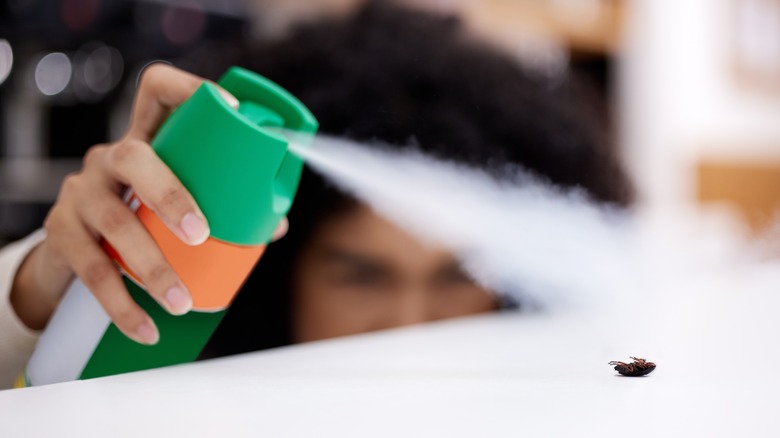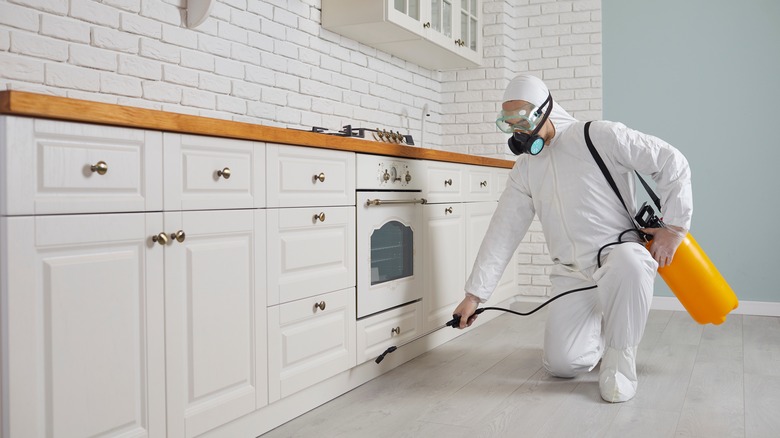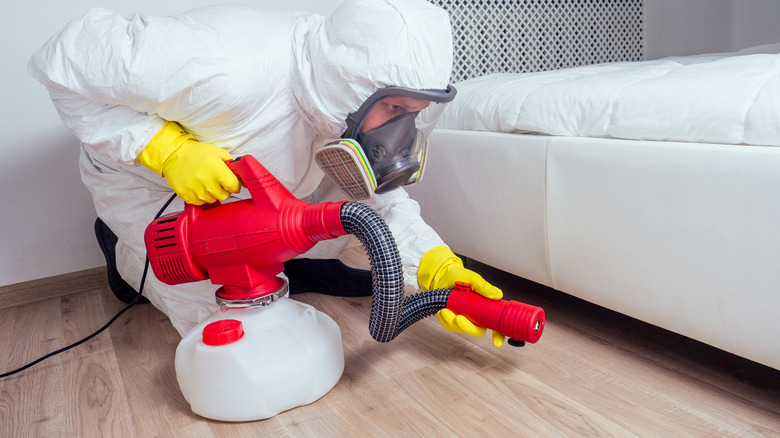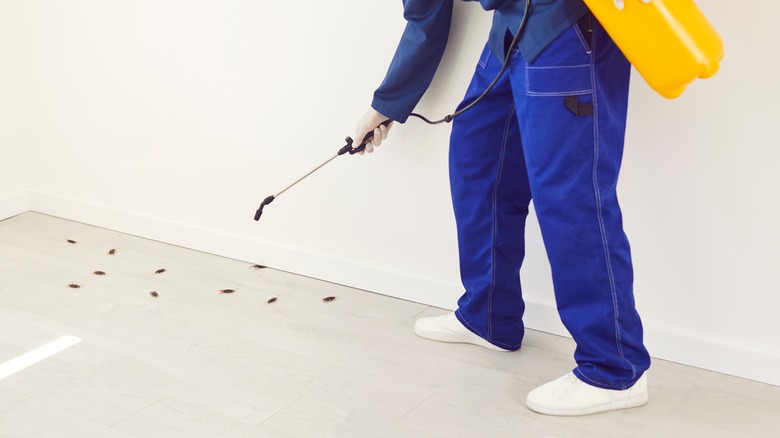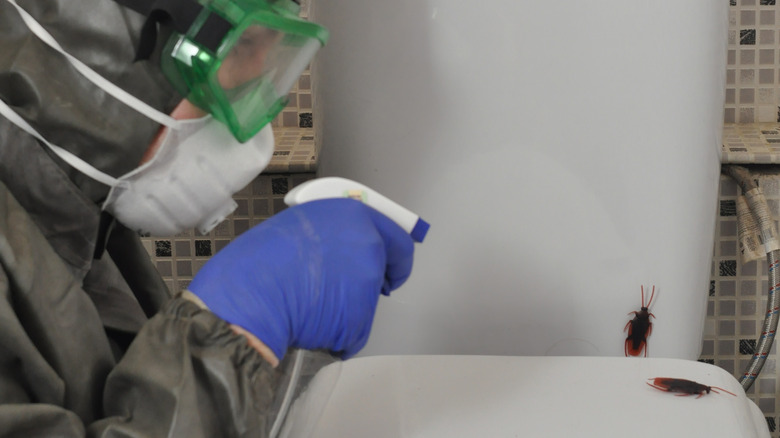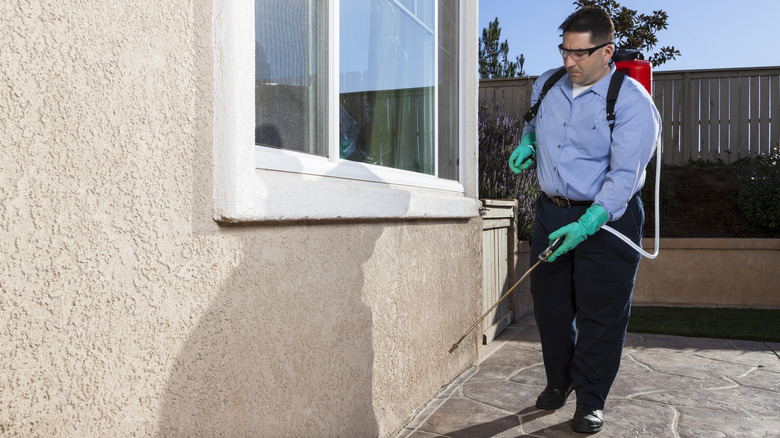All The Places You Should Be Spraying In And Around Your Home For Pests
If you have problems with invading bugs, there are a variety of hacks to try to keep insects out of your house. If those efforts don't work, you may consider reaching out to a professional. However, before you hire professional pest control experts, you may want to try to apply your own insect sprays like an exterminator would do.
There are certain areas inside and outside your home where professionals try to apply insect spray to gain the most benefit from the application. Using sprays in the wrong locations may make the applications less effective. If you are looking for ways to get rid of ants, for example, you don't want to apply a fogger or use sprays in an upstairs attic. You'll want to apply spray directly to areas where you commonly see ants, like along the home's foundation and in kitchen areas where you see the ants congregating. You also need to use sprays safely, avoiding exposing your children or pets to any poisons in the insecticides that could make them sick (via Go-Forth Home Services). Learn more about how to apply pest sprays safely and correctly to eliminate bugs from your home.
How to spray for insects in a kitchen
Once insects enter your home, they commonly move toward the kitchen, where there are food crumbs and moisture readily available. If you fail to dispose of old food or clean the area regularly, insects may appear with more frequency. The kitchen has plenty of dark and small spaces where bugs can hide that are close to sources of food, too.
Apply the spray directly to any areas where you notice insects. In a kitchen, these places can include underneath appliances, in a cabinet underneath a sink, along baseboards, in corners, near any water pipes that have condensation or dripping leaks, and any other crevices inside the room. When spraying for bugs inside a kitchen, always remove or cover your food, utensils, drinking water, and plates in the area. You do not want residue from the bug spray to end up on these surfaces and contaminating them. If you have pets, remove any pet food, toys, or bedding from the kitchen. Make sure the spray dries before allowing the pets back into the kitchen, which should take two to three hours.
Spraying for bugs inside a bedroom or closet
Although people may assume bed bugs are the most common insects to find in a bedroom, many different species can invade your sleeping areas, including fleas, ticks, ants, and cockroaches. You may want to apply a general insect spray to the bedroom if you aren't exactly sure what kinds of bugs you're seeing in the space.
In the bedroom, spray the baseboards around the perimeter of the room. If you have any crevices in the walls or floors, spray these areas, too, which provide a hiding place for insects. If you have bugs, like cockroaches, hiding in the closet, you'll want to remove all the items before spraying. Closets typically contain cardboard boxes that hold various items, which can absorb moisture and attract insects like cockroaches. However, if you believe you have bed bugs specifically, dismantle and apply the spray around the bed frame, behind the headboard, and along the wall where the bed rests. If there are bugs in your dresser, remove the items inside and the drawers before spraying it down. Don't spray inside the drawers or the items inside. Instead, you'll want to wash your clothing items in a washing machine with hot water during a long washing cycle with your normal laundry detergent to try to eliminate bed bugs.
How to spray for insects in a damp basement
Insects inside the home seek out areas where they can hide in dark corners or where they can access moisture. A basement provides most of the elements that insects like. If you have leaky plumbing, condensation on your pipes, or moisture that penetrates the foundation of the basement, you probably will find insects. If you do laundry in the basement, the warmth from the dryer and the moisture from washing laundry may attract them.
Because you probably can close off the basement from kids and pets during the application of the bug spray, you can apply the insect spray liberally and take your time. In an unfinished basement, spray along the base of the walls where moisture may collect. If you have cracks or crevices in the wall, spray these areas. If you have storage boxes in your basement that could retain moisture, you may need to spray for bugs in the storage area, too. If you have a finished basement with a kitchen or food storage areas, you'll want to treat the area like you treat your upstairs kitchen. Spray underneath appliances and check any areas under sinks for signs of insects.
Spray for bugs in moisture-prone areas in bathrooms
Learning where to spray for insects in a bathroom follows many of the same techniques previously discussed. You'll want to pay particular attention to applying the spray in areas where moisture is common in the bathroom, such as underneath your sinks, near and behind the toilets, and near bathtubs or showers. If the bathroom is along an exterior wall, consider spraying along the edges of any window frames. Spray the baseboards and any crevices that you see in the room. You also may want to apply the spray in areas where the pipes extend out of the wall or floor, because condensation on the pipe could leave moisture along the edge of the wall and attract bugs.
You could have insects that are invading your bathroom through the drains in the sinks, bathtub, or shower. If so, you can apply spray around the drains. However, the best way to keep bugs out of your drains is through cleaning any clogs in them or pouring in a drain cleaning solution, like a commercial drain cleaner or a DIY solution.
Applying insect spray around the perimeter of the home's exterior
If you'd prefer to try to keep the bugs out of the home entirely, spraying the outside of the house can create a barrier. Because different insects attempt to enter your home at different times of the year, applying the chemicals along the foundation a few times during the year can help to keep bugs out like flies, ants, and termites. A perimeter spray application is a common technique that professional exterminators use.
When spraying around the exterior foundation of the home, try to apply a continuous band, so you don't have any gaps in the application. As you move around the perimeter, look for areas where two different building materials meet. Apply some extra spray here to maintain the continuous line of the treatment. These areas can include where a brick exterior abuts a wood trim or where door frames are near the foundation. If you have areas where utility pipes or conduit visibly enter the home, spray these spots. By applying bug spray in these areas, you can prevent bugs from gaining easy access to the home through holes or gaps. Before spraying, remove any loose debris, such as mulch or twigs, or any plant material that would interfere with the spray. You should apply the spray so that it dampens the foundation of the house as well as a few inches of the soil that abuts the foundation. By dampening the soil, you'll be able to treat any insects that are living in the soil.
